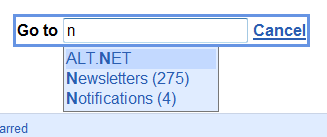Labels and quick links work together
I just realized that the 2 GMail Labs experiments “Go to label” and “Quick links” work together, which makes quick links all the more useful. So say you have 2 labels named “Newsletters” and “Notifications”, and one quick link named “ALT.NET” (which finds all the posts from the ALT.NET mailing list). If you summon the “go to label” popup and start typing “n”, it will show all three:

Now, you ask, when should you use a label, and when should you use a quick link?
The main difference is that quick links are only search queries, whereas labels can be both search queries (a filter that automatically assigns that label) or manually maintained containers. If you need the latter, that’s a no brainer. If, however, what you want can be expressed with a search query, you need to choose between labels and quick links.
My method, so far, is based on 2 criteria: complexity and scalability.
- Make a quick link if the search query is simple, and make a filter if it is complex. Typically, finding out all the emails from a specific mailing list is as simple as typing “list:altdotnet” in the search box, so this calls for a quick link. On the other hand, finding the receipts from some company that also sends you various newsletters and announcements can be a bit more complex, so I would make that a filter. The reason for this is that if the search query is complex, there’s a good chance it’s not complex enough. There’s a good chance some emails won’t get caught, because you didn’t think about all the cases or somehow an exceptional case shows up in your inbox. When this happens, you can still tag that message manually and keep going.
- Make a quick link if similar types of containers exist. For example, “ALT.NET” finds all the mail from a specific mailing list. There could be dozen of similar containers if I’m subscribed to a dozen of other mailing lists. I don’t want to clutter my email organisation with dozens of such labels, so I go for a quick link. My labels tend to be generic concepts that won’t scale up much: “Newsletters”, “MailingLists”, “Receipts”, some labels for my different internet identities and/or email accounts, and some GTD-ish labels (“FollowUp”, “Hold”).
I hope this helps.